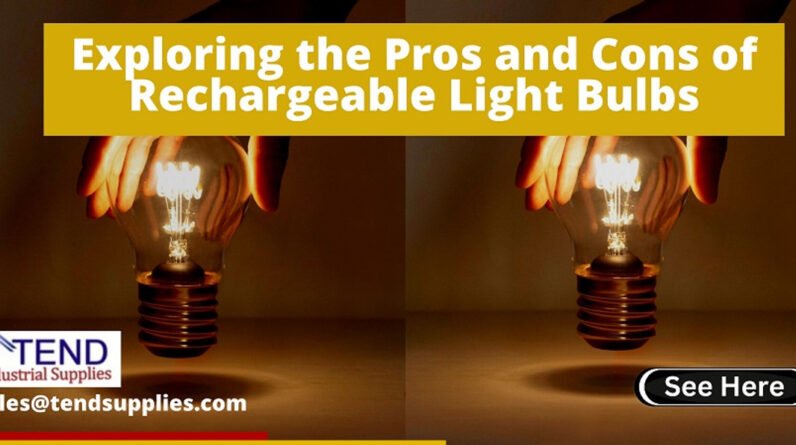
Have you ever wondered if rechargeable bulbs are truly a sustainable and cost-effective lighting solution? In this article, we aim to debunk common myths surrounding rechargeable bulbs and shed light on the truth. From concerns about durability to misconceptions about their environmental impact, we will tackle these misunderstandings and provide you with the essential information you need to make informed decisions about your lighting choices. So, let’s explore the world of rechargeable bulbs and put those myths to rest once and for all.
Busting Common Myths: Shedding Light on Rechargeable Bulb Misunderstandings
Rechargeable bulbs have gained popularity in recent years as more individuals and businesses seek energy-efficient lighting solutions. However, there are still several myths and misconceptions surrounding rechargeable bulbs that may deter some from embracing this technology. In this comprehensive article, we will address and debunk these common myths, providing you with accurate and reliable information to make an informed decision about whether rechargeable bulbs are right for you.

Myth: Rechargeable bulbs are expensive
Rechargeable bulbs have higher upfront costs but long-term savings
It is true that rechargeable bulbs typically have a higher upfront cost compared to traditional incandescent bulbs. However, it’s essential to consider the long-term savings they offer. Rechargeable bulbs are designed to be more energy-efficient, consuming significantly less electricity than traditional bulbs. This translates to lower electricity bills over time, ultimately offsetting the initial investment.
Factors to consider when evaluating the cost of rechargeable bulbs
When considering the cost of rechargeable bulbs, it’s important to analyze various factors. These include the lifespan of the bulb, the cost of electricity in your area, and any available government incentives or rebates. By factoring in these elements, you can gain a clearer understanding of the true cost-effectiveness of rechargeable bulbs.
Comparing the cost of rechargeable bulbs to traditional incandescent bulbs
When comparing the cost of rechargeable bulbs to traditional incandescent bulbs, it is crucial to consider the lifespan of each type. Rechargeable bulbs typically have a longer lifespan, often lasting up to 10 times longer than incandescent bulbs. This not only saves you money on replacement bulbs but also reduces the frequency of maintenance and hassle associated with bulb replacement.
Myth: Rechargeable bulbs have poor brightness
Understanding the different types of rechargeable bulbs available
Rechargeable bulbs come in various types, including LED (Light Emitting Diode), CFL (Compact Fluorescent Lamp), and even newer technologies such as OLED (Organic Light Emitting Diode). Each type differs in terms of brightness, with LED bulbs generally being the brightest option available. Therefore, it’s essential to consider the specific type of rechargeable bulb you are using to determine its brightness.
Advancements in rechargeable bulb technology
Over the years, significant advancements have been made in rechargeable bulb technology, resulting in improved brightness levels. Manufacturers have developed innovative methods to enhance the performance of rechargeable bulbs, ensuring that they provide sufficient and quality lighting. These advancements have debunked the myth that rechargeable bulbs have poor brightness.
Comparing brightness between rechargeable bulbs and traditional bulbs
When comparing the brightness of rechargeable bulbs to traditional incandescent bulbs, it’s important to note that the brightness is measured in lumens rather than watts. Rechargeable bulbs, particularly LED bulbs, can produce the same or even higher levels of brightness while consuming significantly less electricity. Therefore, rechargeable bulbs offer the advantage of both brightness and energy efficiency.
Myth: Rechargeable bulbs have a limited lifespan
Exploring the lifespan of rechargeable bulbs
Rechargeable bulbs typically have a longer lifespan compared to traditional incandescent bulbs. LED bulbs, for example, can last up to 25,000 hours, while traditional incandescent bulbs usually last around 1,000 hours. The extended lifespan of rechargeable bulbs reduces the frequency of replacement, leading to cost savings in the long run.
Factors influencing the lifespan of rechargeable bulbs
Several factors can impact the lifespan of rechargeable bulbs. One essential factor is the quality of the bulb itself. Lower-quality rechargeable bulbs may not last as long as higher-quality ones. Additionally, environmental conditions such as excessive heat or humidity can also affect the lifespan of rechargeable bulbs. Therefore, it’s crucial to choose reputable brands and provide appropriate conditions for optimal bulb performance and longevity.
Proper maintenance and care for rechargeable bulbs
Proper maintenance and care can further extend the lifespan of rechargeable bulbs. Simple practices such as cleaning the bulbs regularly to remove dust and debris can help maintain their performance. Additionally, using appropriate fixtures and avoiding excessive handling or rough usage can also contribute to the longevity of rechargeable bulbs.
Myth: Rechargeable bulbs take a long time to charge
Understanding the charging time of rechargeable bulbs
The charging time of rechargeable bulbs varies depending on the specific technology used in the bulb. Some rechargeable bulbs, such as LED bulbs, have a relatively quick charging time. However, it’s important to note that the initial charge-up time may be longer than subsequent recharges as the battery needs to reach its full capacity.
Factors affecting the charging time of rechargeable bulbs
Several factors can influence the charging time of rechargeable bulbs. The capacity of the battery, the power output of the charger, and the efficiency of the charging circuitry all play a role in determining how quickly the bulb can be recharged. It’s important to follow the manufacturer’s instructions and recommendations regarding the charging process to ensure optimal charging time.
Tips for optimizing the charging process
To optimize the charging process of rechargeable bulbs, it’s advisable to use the recommended charger provided by the manufacturer. Using alternative chargers may affect the charging time or even damage the bulb. Additionally, avoiding overcharging and ensuring that the bulb is fully discharged before recharging can help maintain the battery’s overall performance and lifespan.

Myth: Rechargeable bulbs are not as energy-efficient
Examining the energy efficiency of rechargeable bulbs
Rechargeable bulbs, particularly LED and CFL bulbs, are known for their excellent energy efficiency. LED bulbs, in particular, have a high energy efficiency rating and consume significantly less electricity compared to traditional incandescent bulbs. This results in lower energy costs and a reduced carbon footprint.
Comparing energy consumption between rechargeable and traditional bulbs
When comparing the energy consumption between rechargeable bulbs and traditional bulbs, the difference can be quite substantial. Traditional incandescent bulbs convert a significant portion of the energy they consume into heat rather than light, making them highly inefficient. In contrast, rechargeable bulbs convert a higher percentage of energy into light, ensuring that less energy goes to waste. This energy efficiency advantage reinforces the sustainability and cost-saving benefits of rechargeable bulbs.
The environmental benefits of using rechargeable bulbs
By choosing rechargeable bulbs, you contribute to environmental conservation. The reduced energy consumption of rechargeable bulbs helps lower greenhouse gas emissions and conserves natural resources. Additionally, the longer lifespan of rechargeable bulbs reduces the number of bulbs that end up in landfills, minimizing waste and promoting a more sustainable approach to lighting.
Myth: Rechargeable bulbs are not as durable
Understanding the durability of rechargeable bulbs
Rechargeable bulbs are designed to be durable and long-lasting. LED bulbs, for example, are constructed using solid-state technology, making them more robust and resistant to shock or vibration compared to traditional incandescent bulbs. The durability of rechargeable bulbs ensures that they can withstand various environmental factors, making them suitable for both indoor and outdoor use.
Factors influencing the durability of rechargeable bulbs
Several factors can influence the durability of rechargeable bulbs. The quality of the materials used, such as the casing and internal components, plays a crucial role in determining how durable the bulb is. Environmental conditions, including temperature variations and humidity levels, can also impact the bulb’s durability. Therefore, it’s important to choose high-quality rechargeable bulbs that are designed to withstand the intended usage conditions.
Comparing the durability of rechargeable bulbs to traditional bulbs
When comparing the durability of rechargeable bulbs to traditional bulbs, rechargeable bulbs tend to have an advantage. Traditional incandescent bulbs are more fragile and can easily break if mishandled or exposed to excessive vibrations. Rechargeable bulbs, on the other hand, are built to withstand these conditions, making them a more durable choice overall.

Myth: Rechargeable bulbs have limited options
Exploring the range of options available for rechargeable bulbs
Contrary to the misconception, there is a wide range of options available when it comes to rechargeable bulbs. Various shapes, sizes, color temperatures, and wattages are offered to suit different lighting needs. Whether you’re looking for standard bulbs, floodlights, strip lights, or decorative bulbs, there are numerous options available in rechargeable bulb technology.
Different styles and designs of rechargeable bulbs
Rechargeable bulbs exist in various styles and designs, catering to different aesthetic preferences. From traditional bulb shapes to unique and artistic designs, there is a rechargeable bulb option for every taste. Additionally, many manufacturers offer customizable lighting options, allowing you to choose the level of brightness or color temperature that best suits your needs.
Compatibility with various lighting fixtures
Rechargeable bulbs are designed to be compatible with various lighting fixtures commonly found in both residential and commercial settings. They can be used in standard fixtures, recessed lighting, pendant lights, and even outdoor lighting fixtures. The wide compatibility ensures that you can easily replace traditional bulbs with rechargeable alternatives without the need for any significant modifications.
Myth: Rechargeable bulbs are difficult to dispose of
Proper disposal methods for rechargeable bulbs
It’s important to handle the disposal of rechargeable bulbs properly to minimize environmental impact. Many rechargeable bulbs, such as CFLs and LEDs, contain small amounts of hazardous materials, including mercury. As a result, they should not be disposed of in regular trash. Instead, they should be taken to designated recycling centers or drop-off locations where they can be safely processed.
Ensuring environmentally-friendly disposal
By ensuring proper disposal of rechargeable bulbs, you contribute to minimizing the release of hazardous materials into the environment. Recycling centers are equipped to handle the safe and responsible disposal of rechargeable bulbs, allowing for the recovery of valuable materials and the prevention of pollution.
Recycling options for rechargeable bulbs
Recycling options for rechargeable bulbs are readily available in many areas. Local recycling centers, retail stores, or municipal waste facilities often provide drop-off locations specifically for the recycling of rechargeable bulbs. Additionally, some manufacturers and retailers offer take-back programs, allowing you to return used rechargeable bulbs for recycling.

Myth: Rechargeable bulbs require special chargers
Understanding the charging requirements for rechargeable bulbs
Rechargeable bulbs typically do not require special chargers. Most rechargeable bulbs are designed to be compatible with standard chargers that come with the bulb or can be purchased separately. It’s essential to follow the manufacturer’s instructions regarding the charging requirements to ensure optimal performance and safety.
Compatibility of rechargeable bulbs with various chargers
Rechargeable bulbs are generally compatible with various chargers and power sources. For example, many LED bulbs can be recharged using USB ports, making them convenient for charging with laptops or power banks. However, it’s important to ensure that the voltage and wattage of the charger are suitable for the specific rechargeable bulb you are using to avoid any potential damage.
Benefits of using specialized chargers
While rechargeable bulbs often work well with standard chargers, using specialized chargers can offer additional benefits. Specialized chargers may provide faster charging times, additional features such as dimming options, or compatibility with specific bulb technologies. If you require specific charging capabilities or prefer the convenience of a specialized charger, they could be a worthwhile investment.
Myth: Rechargeable bulbs cannot be dimmed
Exploring dimming capabilities of rechargeable bulbs
Contrary to the myth, many rechargeable bulbs can indeed be dimmed. Dimmable rechargeable bulbs are available in various types, including LED and CFL bulbs. Dimming capabilities offer greater flexibility in creating desired lighting atmospheres, allowing you to adjust the brightness to suit specific needs or moods.
Types of rechargeable bulbs that can be dimmed
LED bulbs are commonly dimmable and offer precise control over brightness levels. It’s important to check the product specifications or packaging to ensure that the specific rechargeable bulb you choose is dimmable. Not all rechargeable bulbs have dimming capabilities, so it’s crucial to select the appropriate bulb type to achieve the desired dimming effect.
Methods for dimming rechargeable bulbs
Dimming rechargeable bulbs can be achieved through various methods depending on the bulb type and the dimming system in place. Common methods include using compatible dimmer switches, smart lighting systems, or remote controls. It’s important to follow the manufacturer’s instructions and recommendations when dimming rechargeable bulbs to ensure proper functionality and avoid any potential damage.
In conclusion, there are many myths and misconceptions surrounding rechargeable bulbs. However, by addressing and debunking these myths, we can shed light on the truth and provide you with accurate information to make informed decisions. Rechargeable bulbs offer various benefits, including long-term savings, improved brightness, extended lifespan, efficient charging, environmental friendliness, durability, a wide range of options, safe disposal methods, compatibility, and dimmable capabilities. By embracing rechargeable bulbs, you can enjoy the advantages of energy-efficient lighting while contributing to a sustainable future.





